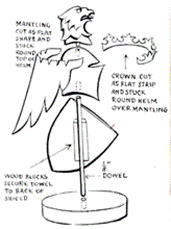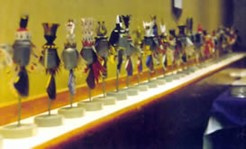John Ferguson, FSHA
Heraldry as an art form is not only pattern, colour and virile draughtsmanship. It has, in its original state, form, texture and movement. The cold weight of iron, the feel of hardened leather and the qualities of carved wood, all enlivened by the fluttering of coloured cloth, come together to form the basis of what so many of us delight in as heraldic artwork. Perhaps this is why those of us who draw and paint heraldry sometimes feel that when the painting is finished it is still incomplete. Something is lacking – it is two-dimensional.
 These little models are an attempt to capture at least some of this missing quality and to express something of the mass and movement, the colour and the textures of heraldry. Constructed from the bits and pieces, the offcuts of paper, vellum, card and wood accumulated while working in the studio, they are painted in gouache colours and stand about five or six inches high when finished and assembled.
These little models are an attempt to capture at least some of this missing quality and to express something of the mass and movement, the colour and the textures of heraldry. Constructed from the bits and pieces, the offcuts of paper, vellum, card and wood accumulated while working in the studio, they are painted in gouache colours and stand about five or six inches high when finished and assembled.
Little equipment is needed to make them. A sharp blade, some fine sandpaper, rat tail files, a tube of fast-drying glue and a small drill. For colouring, a couple of small sable brushes and a few tubes of gouache colour. When making the model it is important to paint each piece before assembly. The amount of detailed painting could be done only with considerable difficulty if the model was assembled before painting!
 Carve the helm from a piece of hardwood. Then drill a hole in the crown and another underneath the face of the helm. The hole in the crown will accommodate the spike which in turn supports the crest. The hole underneath will take the upright pole on which the whole assembly is mounted. The crest is made from wood or paper or, indeed, any suitable fragment of material which is to hand.
Carve the helm from a piece of hardwood. Then drill a hole in the crown and another underneath the face of the helm. The hole in the crown will accommodate the spike which in turn supports the crest. The hole underneath will take the upright pole on which the whole assembly is mounted. The crest is made from wood or paper or, indeed, any suitable fragment of material which is to hand.
Throughout my collection of models there is a remarkable variety of materials to be found ranging from fuse wire to gold embossed cake frilling. On one occasion split lentils were used to yield a suitably textured surface! Wings, crowns, mantling etc., are made of paper” and bent into shape. Shields are of wood using close-grained hardwood, sometimes augmented with surface laid paper (for labels etc). The shield is then attached to the upright dowel which is, in turn, set into the wooden base. This dowelling (1/8th inch, 3mm) is ideal for this upright and for the little spike holding crest to helm. Ramin or lime are ideal woods but balsa should be avoided.
The only other essential requirements are – patience, and an understanding wife who will tolerate shavings on the carpet and provide sympathy when the wood splits!
